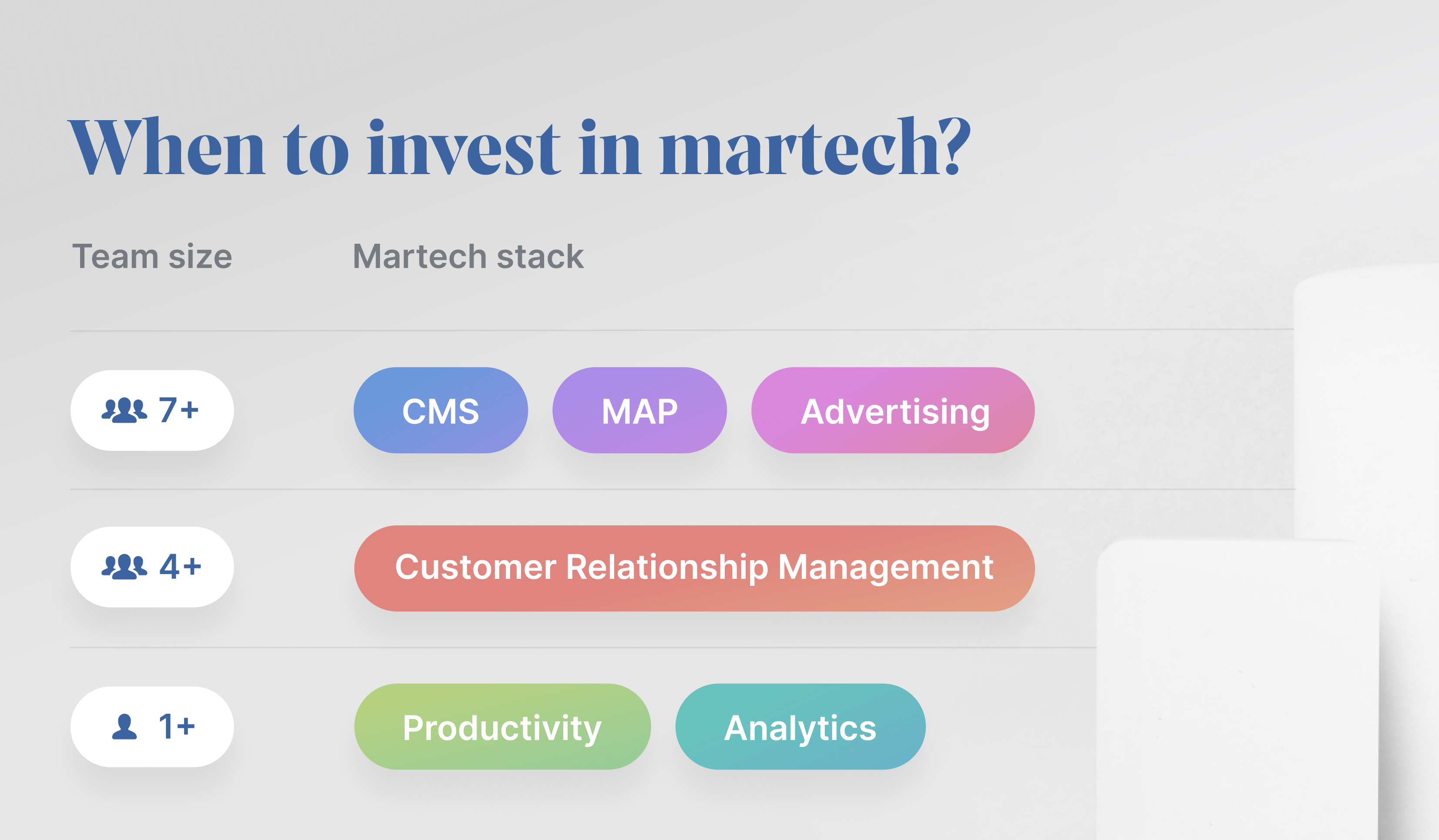The State of B2B Marketing Teams 2023
What does the average marketing team in B2B tech look like today?

10 minutes
Introduction
To date, 630 tech companies laid off over 185,000 employees and counting in 20231. As a result, companies must reconfigure their teams with smaller headcounts, lower budgets, and ever-increasing expectations.
In 2023, marketing teams, are under more pressure than ever to deliver revenue and are often one of the first teams to get cut when layoffs occur. With such high stakes, marketing leaders must ensure they have the team structure and tools to deliver results. As many companies look to drive efficient growth in 2023, the ability to answer the following questions about their marketing team is key:
- How many marketers should we have on our team?
- What roles should we be prioritizing and at what experience level?
- What tools does our marketing team need to be successful and when should we invest in them?
Using Clearbit’s proprietary B2B contact database, with over 50 million companies and 389 million professional contact records and counting, we analyzed over 900,000 marketers in more than 54,000 B2B tech companies in North America to determine the state of marketing teams today. From headcount to seniority, martech stack, and more, here’s a look at the average B2B tech marketing team in 2023.
Key Findings
- B2B marketing departments make up about 5% of the total employee count
- Out of the top 10 B2B marketing titles, only 3 are specialized roles: Product Marketing Manager, Digital Marketing Manager, and Product Marketing Director.
- Marketers want tools that provide insight. More than 50% of marketing teams are using productivity and analytics tools before they reach their first million in annual revenue.
- More than 40% of one-person marketing teams rely on a content management system.
- By the time marketing teams reach a headcount of 5, over 25% of them have advertising, analytics, content management, customer relationship management, marketing automation, and productivity tools to power their martech stack.
The structure of B2B marketing teams
What do B2B marketing teams in tech look like in 2023? Below, is a look at the typical marketing team broken down by size and roles across various company sizes and earnings.
How big are B2B marketing teams in tech?
Having trouble viewing this chart? Click here
Based on our findings, B2B marketing teams make up about 5% of a company’s total employee count. But employee count is not the most important measurement of how big your marketing team should be. There are various factors that can impact how to structure your marketing headcount including things like company goals, marketing budget, and revenue. When we look at the average B2B marketing team size by estimated annual recurring revenue, the size of the team continues to grow as revenue grows.
What roles make up B2B marketing teams in tech?
Having trouble viewing this chart? Click here
*Similar titles are grouped for consistency. Seniorities such as “senior” or “junior” are excluded from the associated title for consistency.
Top 10 marketing titles by company ARR
Having trouble viewing this chart? Click here
In 2023, senior-level marketers are expected to have a wide range of marketing knowledge. Seven out of the top ten marketing titles are marketing generalists. Interestingly, two of those specialized titles are product marketing roles. And when it comes to executive-level titles, VP of Product Marketing is the only title to reach the top 50 list at number 23.
When we look at the top 10 titles for companies at different revenue stages, Product Marketing Manager is the most popular role between $50M and $500M estimated ARR. With less than 12% of product marketing support coming from individual contributors or consultants. Experience and in-house knowledge is critical for this specialty—which is why 30.5% of product marketers have a director-level title or higher. Considering the majority of the top 10 titles are generalized marketing roles, the product marketing position is a key function for all B2B marketing teams in 2023.
The top 10 roles at different revenue stages tend to stay the same (although the importance of each role shifts) until a company reaches $250M in estimated ARR. At this stage, we start to see titles with more seniority or specialization such as Engagement Manager, Content Marketing Manager, or Technical Marketing Manager.
Ryan Narod
Generalists vs. specialists in the time of AI
Once marketing teams get more mature it's important to have specialists who overlap. Those specialist roles would be marketing operations, product marketing, someone who understands inside sales and sales enablement, and content marketing.

Having trouble viewing this chart? Click here
This chart shows the upward progression for various B2B marketing specialties. In 2023, most executive titles are generalized. When we look at all marketing executives (not pictured), 7.89% hold an executive title in Digital Marketing, 4.29% in Product Marketing, 2.68% in Brand Marketing, and 2.27% in Content Marketing. Less than 1 percent of all other specialties hold executive titles.
50% or more of the marketers in creative specialties like Copywriting and Social Media are individual contributors or consultants. Less than 2% of Copywriting and Social Media specialists have executive-level titles with Channel (2.5%), Field (2.6%), and Content (3%) marketers following closely behind. Despite both being in the top 15 most popular B2B marketing titles, 13.5% of Content Marketers hold director-level positions compared to 1.8% of Copywriters. This difference shines a light on how even the slightest shift to a more generalist role can open more leadership opportunities for marketers.
Kaylee Edmondson
How marketers can support retention efforts
Having trouble viewing this chart? Click here
Our findings show that the number of director-level titles makes up about 20% of marketing positions at companies over $1M in estimated ARR. Despite a declining percentage of executive leadership as companies grow, the percentage of director-level titles stays the same.
Experience is critical for businesses looking to grow into a billion-dollar company. When companies are between 50 and 1,000 employees, the percentage of marketing leadership (director-level and above) doesn’t drop below 33%. Similarly, when we look at ARR, as companies grow past $50M, 75% of marketers have a manager-level title or above. But, seniority comes at a cost. At that same $50M+ threshold, the percentage of executive titles begins to decline as reliance on marketing managers increases. According to the 2023 MarTech Salary and Career Survey2, executive-level positions make 2x more salary than staff positions.
Kevin Tate
The marketer's path to the C-suite
I wouldn't trade my sales and demand gen background for anything. It gave me an incredible filter for what's useful language vs. marketing speak and ensures that I'm thinking about pipeline and revenue outcomes above everything else. Both of these things keep me very close with sales stakeholders, which is hugely valuable for marketing teams.

What tech are B2B marketing teams using?
Having trouble viewing this chart? Click here

When it comes to the tech marketing teams are investing in, tools that provide insight are leading the pack. Productivity tools, like Slack and Atlassian, and Analytics tools, like Google Analytics and Alteryx, are prioritized at every stage of a company’s growth.
The third most invested-in technology for marketing teams is Customer Relationship Management (CRM) software, like Salesforce or Pipedrive. The percentage of marketing teams using a CRM after reaching $1M in estimated ARR increases by 25% and increases again (24%) after they reach $10M. The need for a CRM grows naturally with a company as they grow, both in employee count and in revenue.
Stephen Stouffer
Leveraging iPaaS to build your best in breed martech stack
For startups, however, a CRM may come after a Content Management System (CMS), like WordPress or Contentful. In fact, 40% of one-person marketing teams rely on a CMS, and 44.25% of companies invest in a CMS before they reach over $1M in estimated ARR.
Investment in lead generation technology such as Marketing Automation tools, like Hubspot and Marketo, or Advertising tools, like Facebook Advertising and Adroll, tend to follow a similar pattern, rising as companies grow. Live Chat tools, like Drift and Intercom, and Image and Video tools, like Wistia and Vimeo, are the exception to this trend as they reach their peak at 1,000 employees or the $250M - $500M range in estimated ARR. Interestingly, more than 50% of B2B marketing teams have yet to invest in video and image tools, despite the rising demand for more video in marketing across all industries.
Kaylee Edmondson
Why marketers should double down on their media arm
For the most part, the use of marketing technology tends to increase as a company’s employee count or ARR rises. This is also shown in the 2023 SaaS Management Index by Zylo3 which found that the average number of applications used by companies under 500 employees is 172, and rises to 255 when a company is between 500 and 2,500 employees. By the time companies surpass 10,000 employees, they average 664 applications across all departments. The report also found that SaaS spending is down across all categories with a few exceptions. For marketers, spending on Lead Generation applications is up by 54.9%.
Knowing which marketing roles and technology to invest in and when, is critical for marketing teams looking to scale efficiently. Want to dive deeper into the state of B2B marketing? Check out all of our interviews with top B2B marketing experts.
Methodology
The data in this report was gathered in January 2023. Over 900,000 contacts with marketing titles from over 54,000 B2B tech companies in North America were analyzed. Learn more about Clearbit’s data here.
